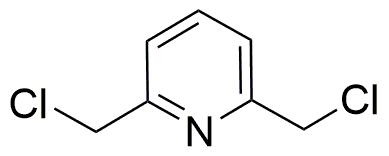2,6-Bis(chloromethyl)pyridine is widely utilized in research focused on:
- Synthesis of Pharmaceuticals: This compound serves as an important intermediate in the synthesis of various pharmaceutical agents, particularly those targeting neurological disorders.
- Development of Agrochemicals: It is used in the formulation of herbicides and pesticides, enhancing crop protection and yield by effectively targeting specific pests.
- Polymer Chemistry: The compound acts as a cross-linking agent in the production of specialty polymers, improving their thermal and mechanical properties.
- Research in Organic Chemistry: It is a valuable reagent in organic synthesis, facilitating the creation of complex molecular structures for academic and industrial research.
- Material Science: This chemical is employed in the development of advanced materials, such as coatings and adhesives, that require specific bonding characteristics.
General Information
Properties
Safety and Regulations
Applications
2,6-Bis(chloromethyl)pyridine is widely utilized in research focused on:
- Synthesis of Pharmaceuticals: This compound serves as an important intermediate in the synthesis of various pharmaceutical agents, particularly those targeting neurological disorders.
- Development of Agrochemicals: It is used in the formulation of herbicides and pesticides, enhancing crop protection and yield by effectively targeting specific pests.
- Polymer Chemistry: The compound acts as a cross-linking agent in the production of specialty polymers, improving their thermal and mechanical properties.
- Research in Organic Chemistry: It is a valuable reagent in organic synthesis, facilitating the creation of complex molecular structures for academic and industrial research.
- Material Science: This chemical is employed in the development of advanced materials, such as coatings and adhesives, that require specific bonding characteristics.
Documents
Safety Data Sheets (SDS)
The SDS provides comprehensive safety information on handling, storage, and disposal of the product.
Product Specification (PS)
The PS provides a comprehensive breakdown of the product’s properties, including chemical composition, physical state, purity, and storage requirements. It also details acceptable quality ranges and the product's intended applications.
Certificates of Analysis (COA)
Search for Certificates of Analysis (COA) by entering the products Lot Number. Lot and Batch Numbers can be found on a product’s label following the words ‘Lot’ or ‘Batch’.
*Catalog Number
*Lot Number
Certificates Of Origin (COO)
This COO confirms the country where the product was manufactured, and also details the materials and components used in it and whether it is derived from natural, synthetic, or other specific sources. This certificate may be required for customs, trade, and regulatory compliance.
*Catalog Number
*Lot Number
Safety Data Sheets (SDS)
The SDS provides comprehensive safety information on handling, storage, and disposal of the product.
DownloadProduct Specification (PS)
The PS provides a comprehensive breakdown of the product’s properties, including chemical composition, physical state, purity, and storage requirements. It also details acceptable quality ranges and the product's intended applications.
DownloadCertificates of Analysis (COA)
Search for Certificates of Analysis (COA) by entering the products Lot Number. Lot and Batch Numbers can be found on a product’s label following the words ‘Lot’ or ‘Batch’.
*Catalog Number
*Lot Number
Certificates Of Origin (COO)
This COO confirms the country where the product was manufactured, and also details the materials and components used in it and whether it is derived from natural, synthetic, or other specific sources. This certificate may be required for customs, trade, and regulatory compliance.

